Internet Speeds Around the World

In the 1990s and 2000s, internet users were used to waiting dozens of minutes, sometimes hours, just to download an image or audio file.
Today, we expect high-definition video to stream with no interruption or time for “buffering.”
Yet, not all internet connections are created equal.
How quickly and efficiently your connection downloads data can determine your experience on the internet.
Across the world, as high-speed connections become more readily available, there are also a wide range of costs associated with connectivity. Below, we take an in-depth look at these costs and the average speeds in nations around the world.
The Cost of Connectivity
The United States is, ostensibly, the nation that created the internet, but the US consistently has slower speeds and higher costs than users in Europe or Asia.
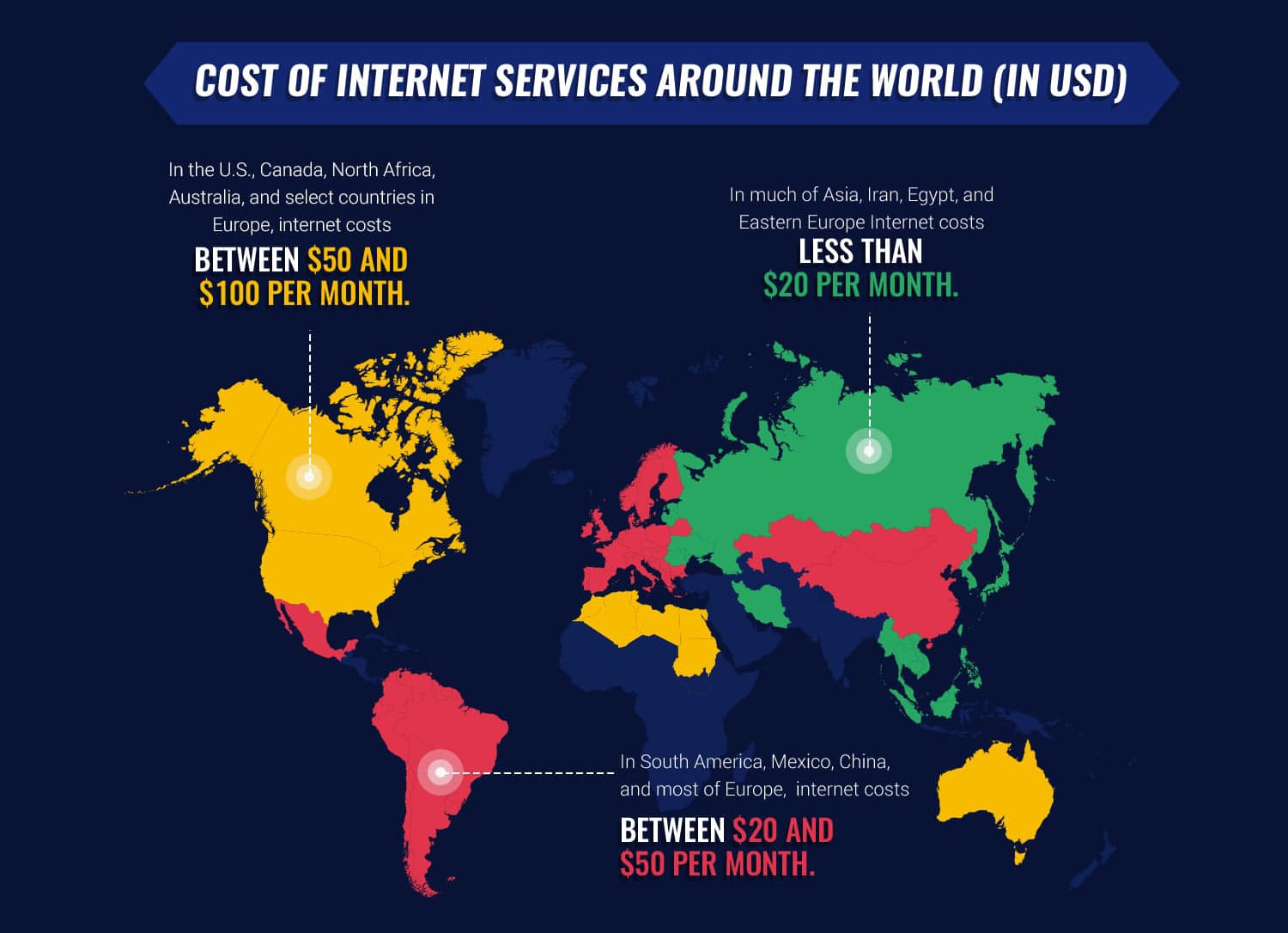
About half of the population of the world can’t get online in any way, according to Google India’s managing director Rajan Anandan. Those who can pay anywhere from a couple of bucks to more than $500 each month for the privilege.
In places like Iran, most of Asia, and Egypt, high-speed internet costs about $20 per month. This is similar to the price that folks in Eastern Europe pay.
Western Europeans pay between $40 and $60 for access to the internet.
In South America, where internet speeds are painfully slow, the service costs anywhere from a few US dollars per month to as much as $20.
In some of the most remote places on Earth, specifically the Far East and in Africa, a person will have to pay anywhere from $100 to $500 for internet.
So, as you can see, there is a wide variety of cost.
Average Price per GB of Data (In USD) and Speeds Around the Globe
- United States – $46.62 – 13 Mbps (Avg)
- United Kingdom – $21.91 – 14.2 Mbps
- France – $17.20 – 8.9 Mbps
- China – $19.92 – 4.1 Mbps
- Russia – $6.86 – 11.6 Mbps
- Brazil – $10.35 – 4.1 Mbps
- India – $3.77 – 2.8 Mbps
There are two factors that go into determining both the available speed of internet service and the cost to access them.
The first is infrastructure available, specifically phone lines, coaxial cables, or fiber optic cables. These are the pathways that data uses to get from the internet to your computer.
The second factor is simply basic economics, there needs to be real competition amongst internet providers.
With these two things in place, there are incentives to offer competitive lower prices and higher speeds. If there is just one or a few companies involved, the cost of building the infrastructure is greater, and there is no good business reason for them to ever lower their prices.
The Problem of Competition and Infrastructure
There are no easy answers when it comes to dealing with how a lack of competition or an unwillingness to invest in infrastructure slows the growth of the internet. Newer technologies in both phone-line connections and fiber optic connections can easily boost speeds, but it takes serious investment.
With the rate that technology changes in the modern age, it seems almost unprofitable to invest in these upgrades, because in just a few years it’s time to do it all over again. Some people believe that government should heavily invest in these upgrades, bringing broadband to remote, rural areas and maintaining the existing infrastructure like they do with roads, the electrical grid, and other public utilities.
In Europe, where speeds are comparable to the U.S. but the prices are much less, the infrastructure was built almost wholly by private investors. That’s why some believe government regulation of the industry itself is the key.
In the early 2000s they passed a law requiring the telephone company to share its infrastructure with competitors. They lease the lines and offer their own services. They found that the areas where this plan went into effect saw faster speeds and lower pricing options. The average speed in the UK is slightly higher than the average speed for the US, but the average price-per-GB in America is more than twice that of the UK.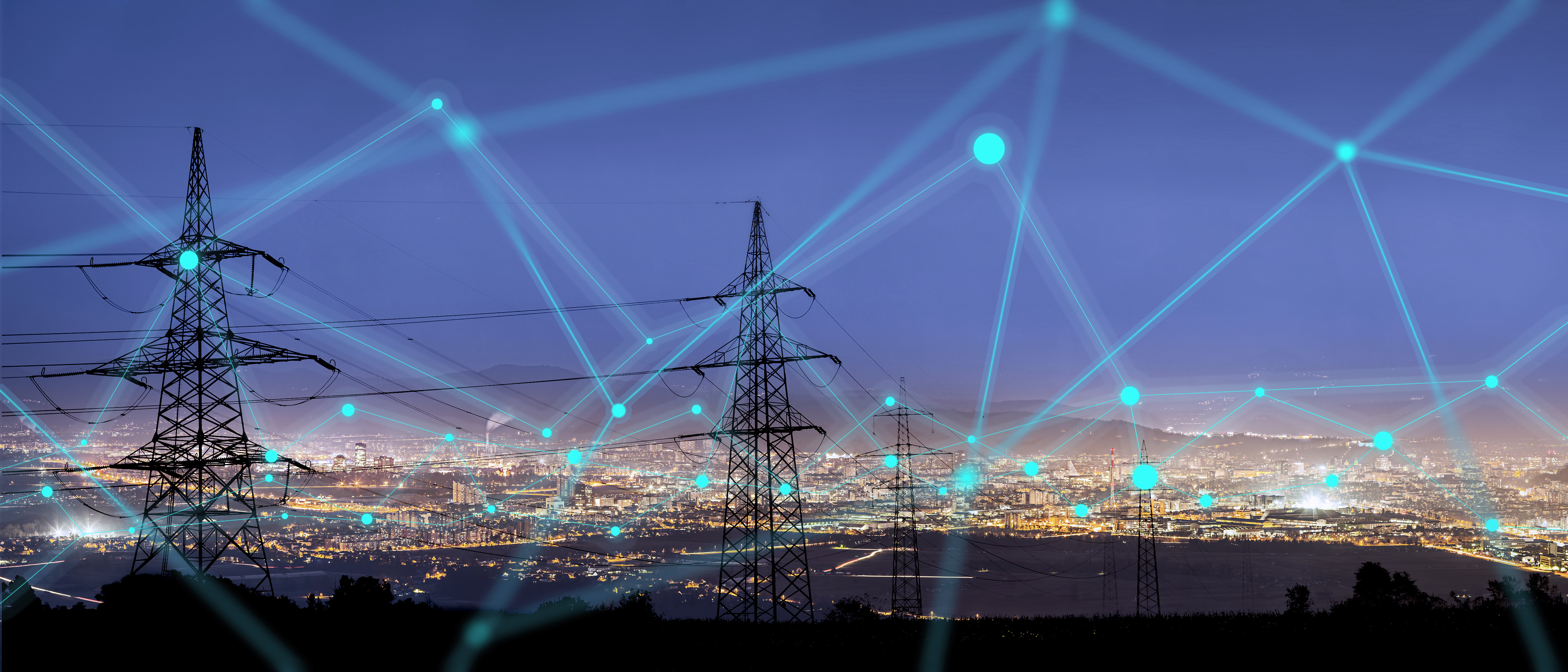
How these issues have played out in the United States and the United Kingdom is a good comparison. At the dawn of the internet age, both countries had the same problem with respect to competition. The people who built the infrastructure were those who already had it mostly in place, the phone and cable companies. While the US let the status quo continue, limited options based on the region, the UK took a different approach.
Case Study: France Vs the U.S.
A 2015 report from the Center of Public Integrity looked at the dispersal of internet service in select American cities and contrasted these with cities of comparable size in France. They looked at 5 US cities in different parts of the country, finding that while there is very little competition. DSL and fiber suppliers tend to avoid encroaching on one another’s service areas, and the same is true for competing cable providers.
In Seattle, Washington there are only 3 providers who offer high-speed service (50 Mbps or more), but there is no place in the city where all 3 compete against one another. In many places, these companies have no competition at all.

In the comparable French cities, users have no fewer than 6 different options for providers. France has a similar system of open-access to the infrastructure. This seems to work very well at keeping the costs low, but not so much in encouraging upgrades to the infrastructure.
Critics of the open-access system say that those who lease the networks have no incentive to contribute to upgrading them.
There may be some truth to that.
Because while French users have the choice of multiple providers, a few of the US cities examined offer significantly faster premium service. Nimes, France and Pittsburgh, Pennsylvania are cities of a similar size. In Nimes, who boasts eight different providers, the fastest and most expensive plan only costs about $35 per month. But the top speed is 70 Mbps.
Pittsburgh has only two providers, Comcast and Verizon. Yet, they each offer more expensive plans with higher speeds. Comcast users can get 105 Mbps for around $76 or 150 Mbps for around $115. Verizon is more expensive at these levels for the same speeds, with a plan for $75 at 75 Mbps and around $125 for 150 Mbps. But Verizon, thanks to the speeds available through fiber optic cables, also offers 300 Mbps and 500 Mbps plans. These come with a hefty price tag, around $195 and $285 respectively.
If France installed a fiber optic network subject to the same open-access rules, it’s safe to assume the competition of other providers would drive prices down.
High-Speed Internet in the Developing World
Broadband speeds in developing countries in Africa and Asia are, compared to the U.S. or Europe, abysmally slow.
However, because of the pace at which technology moves and the realities of building this sort of infrastructure make it difficult to offer high-speed broadband.
In India, one of the countries that’s least-connected in the world, access to high-speed internet is very rare.
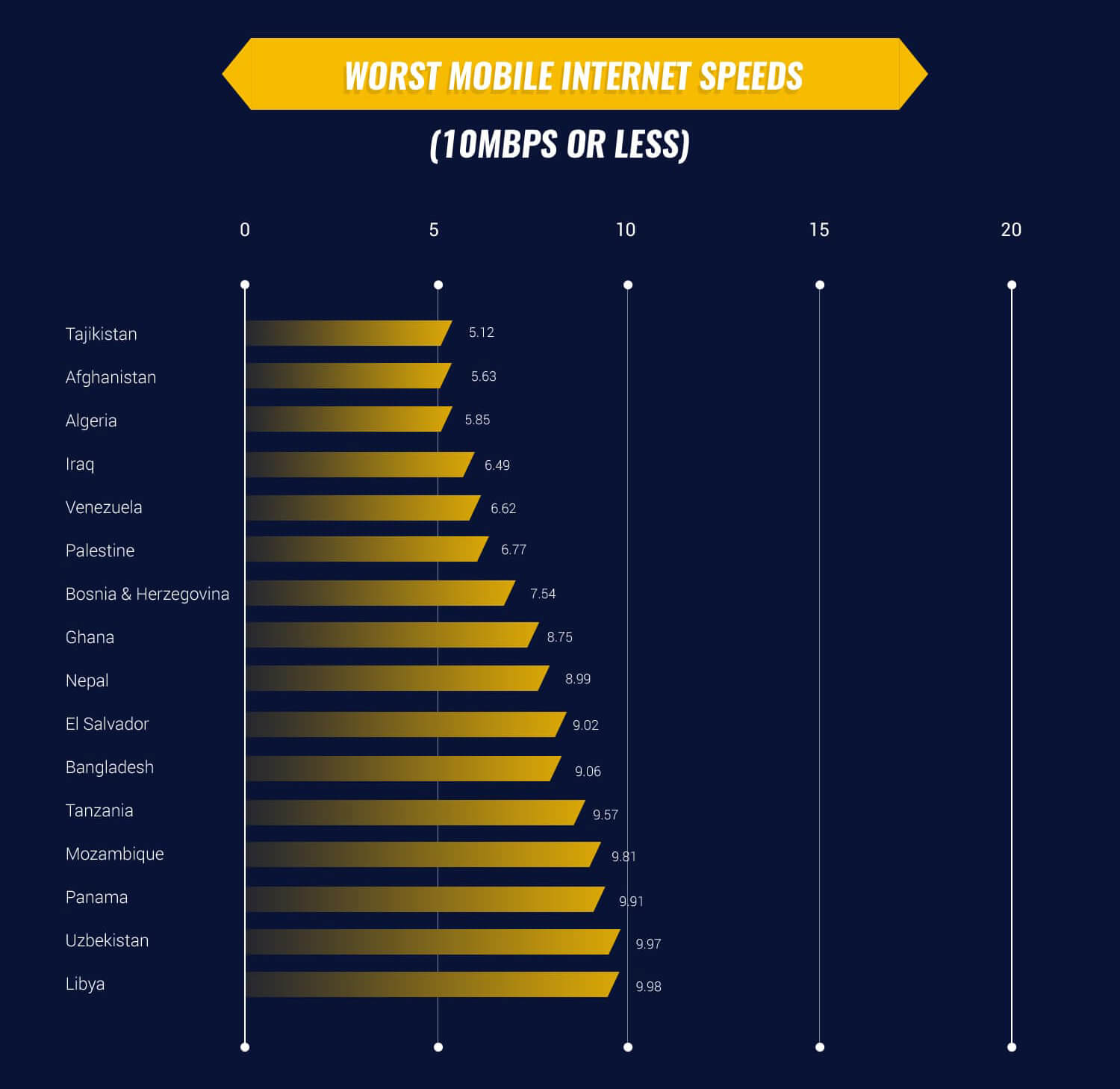
Companies like Facebook or Google are trying to change that. Hundreds of train stations across the country will offer free WiFi thanks to an initiative from Google. Facebook hopes to install 20,000 WiFi hotspots, selling access to this service for 10 rupees.
In 2017, CNN reported that the Indian government hoped to bring 250,000 hotspots to more than 1,000 villages.
Yet, for most of the unconnected world, it will be mobile internet rather than broadband that will put the rest of the globe in the palms of their hands.

In the Middle East, Africa, and in China, where for reasons ranging from geographic limitations to war, prevented fixed infrastructure improvements. However, the mobile phone market continues to grow in these places. The way the majority of people in these places access the internet is via their smartphones.
China saw the great success with mobile integration in their own country, and they looked to the African continent to further grow their businesses. They developed phones that met their specific needs.
For example, some African countries have to conserve power, meaning the electricity is shut off for hours. In others, people have to walk miles to find an outlet to charge their phone. For these customers, longer battery life is a primary concern. While the mobile internet speeds can be low, this is not a concern for these customers. At least, not yet.
How We Connect to the Internet
When we talk about internet speed, we’re talking about how quickly a user can access data via the web or applications. Measured in megabytes-per-second, for now, these speeds can vary from just a few Mbps to hundreds of Mbps. To better understand this, we need to look at where we came from all the way to where this technology might be going. In ten years, we may measure internet speeds in gigabytes-per-second. Twenty years ago, the speeds were typically measured in kilobytes-per-second. How users connect to the internet, specifically what technology the use, determines how fast or slow they can travel the “information superhighway.” Below we will examine how the earliest internet pioneers logged on, the most common options today, and where things might be headed in the future.
The Days of Dial-Up Modems
For people of a certain age, the term “modem” immediately brings to mind a kind of high-pitched, scratchy melody that accompanied their logging on to early internet portals like America Online. These were devices that used regular phone lines to transfer data back-and-forth. Originally called a “modulator-demodulator,” the device became better known as a modem.
The technology was originally invented for the US military as far back as 1941. However it wasn’t until 1958 that they were mass-produced to connect Cold War-era air defense systems, so they could respond quickly in case of an attack. At the time, the Bell System was a monopoly, owning all the phone lines.
The only way to use civilian modems was to place the handset of a phone in a cradle known as an acoustic coupler. Eventually, though, modems were able to directly plug into the phone lines.
By the 1990s, computers and fax machines were a staple of the business world and were just entering the home consumer markets. The typical modem speeds were between 14 Kbps and 33 Kbps.
The limit on these devices seemed to be reached at 56.6 Kbps, but thanks to compression they were able to surpass it. Through file compression, pure text files could transfer at a rate of 320 Kbps. When it came to files that were already compressed, like early image and music files, the compression trick wouldn’t work.
However, some people still use this technology.
Think about that for a minute…
In rural areas where there is no high-speed internet, a modem through the phone-line is their only option for accessing the internet. However, the bit rate is just too small to accommodate things like streaming music or video. The internet is outgrowing the modem’s capability.
Digital Subscriber Lines, the Faster Phone-line
Originally known as Digital Subscriber “Loops,” DSL devices offer high-speed internet using phone lines. The seeds of this technology date back 40 years to 1979, but the cost of making the chips needed for the DSL modem was too high until the 1990s.
Yet, what helped this technology spread was that existing cables could be used to transmit this data. Users couldn’t just plug a DSL line into their phone jacks, though. Still, the cost of the new equipment needed to make this type of connection work was much cheaper than running fiber-optic cables.
Using the existing infrastructure, people were able to get high-speed internet. Unlike phone modems, users stayed connected to the internet at all times. Also, if they got a phone call, it wouldn’t interrupt the internet service.
DSL users can experience speeds of up to 1000 Mbps, and it’s still the most economical choice for users.
In the US, the phone lines are regulated by the FCC, whereas cable and fiber optic lines are not. Thus, the phone companies were forced to lease their network to competitors, like in Europe. Thanks to this, the cost of a DSL subscription ended up being cheaper than dial-up modems, especially since some dial-up providers still charged by the minute.
With higher bandwidth at their disposal, users began to use the internet for file-sharing, specifically videos and music. For example, using dial-up, a 40 MB collection of songs would take nearly 100 minutes to download on a 56.6 Kbps modem. That same file collection would take anywhere from 20 minutes to 33 seconds to download using DSL. Yet, with higher and higher demands placed on the networks, to the more consistently dependable cable and fiber optic providers.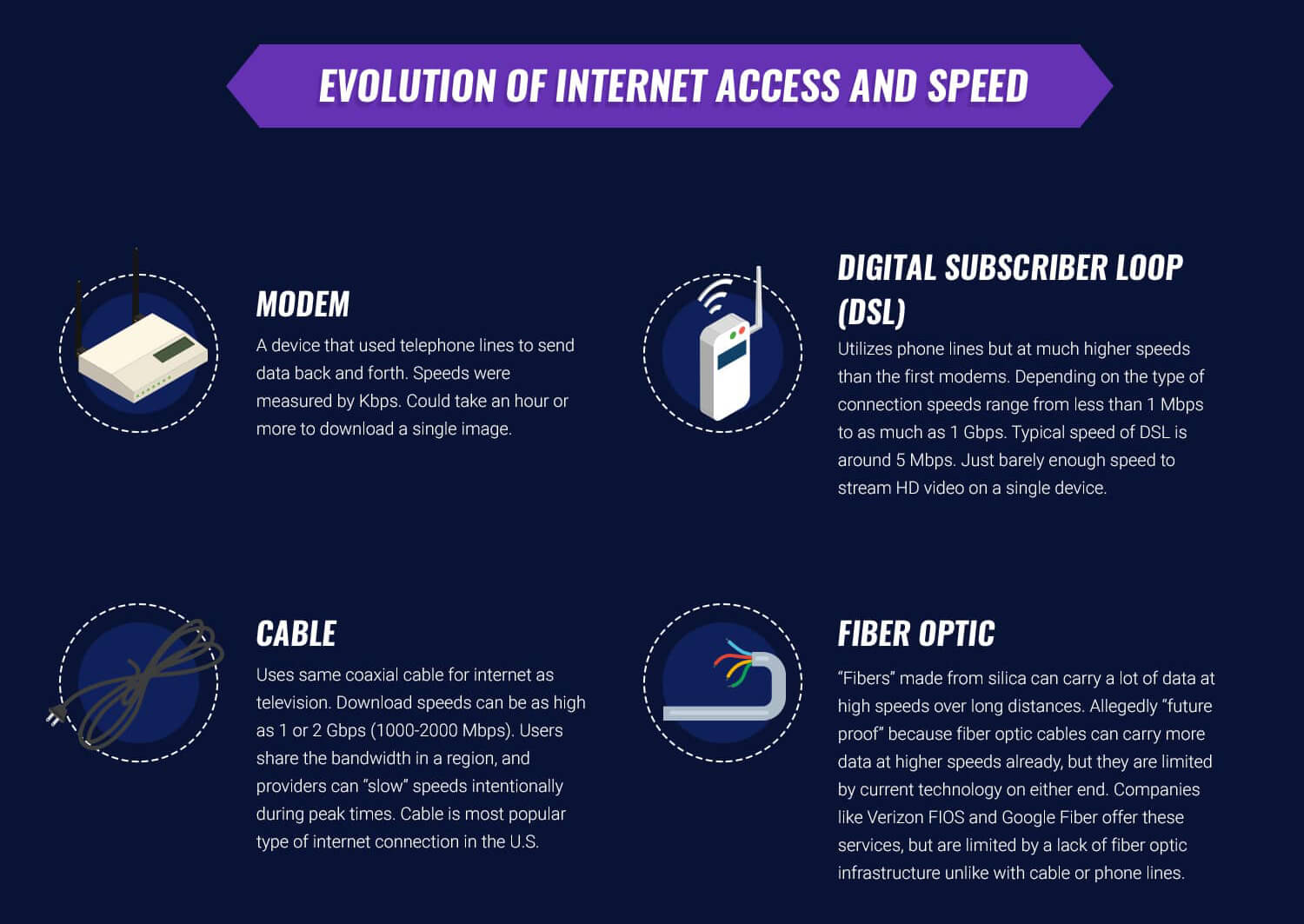
Internet via Coaxial Cable
Just like with DSL service, cable internet uses the existing coaxial cable television lines to transmit data using a modem especially designed for this service.
However, unlike the phone infrastructure, the FCC does not regulate cable companies that way. Thus, these companies are not forced to share their networks with smaller competitors and consumers usually have to pay high costs for faster internet. Typically, these companies offer internet as a part of a “bundle,” meaning a monthly rate that pays for their high-speed internet, cable service, and landline phone service.
As mentioned above, the cable companies have seemingly deliberately carved up their service areas to reduce competition. So, while users may not have as many lower price options, the companies themselves are motivated to update their infrastructure to ensure their customers get the fastest service possible.
Users can experience download speeds of up to 1000 Mbps using cable internet, and their upload speeds can reach 500 Mbps. However, due to the nature of cable internet, these speeds are not always consistent.
In many of the residential service areas, users are forced to share the available bandwidth. This means that in areas where there aren’t a lot of simultaneous users, such as rural communities, speeds can be significantly faster than in dense, urban population centers.
During times when usage is at its peak, operators have to “throttle” the bandwidth, limiting the speeds available. They can also place a cap on bandwidth, which effectively shuts down the service for that user. The cap can, of course, be removed, but it usually requires the subscriber to pay further fees. Yet, critics of this practice say it’s by cable providers, because newer technologies make bandwidth caps unnecessary.
Satellite Internet Access
Just as they compete with cable providers in the television markets, satellite providers also offer internet services. The idea of a geosynchronous satellite, in a “fixed” position in orbit by following the rotation of the Earth, has been around since 1928, but didn’t become a popular idea until science fiction legend Arthur C. Clarke wrote a paper about it in a 1945 edition of Wireless World.
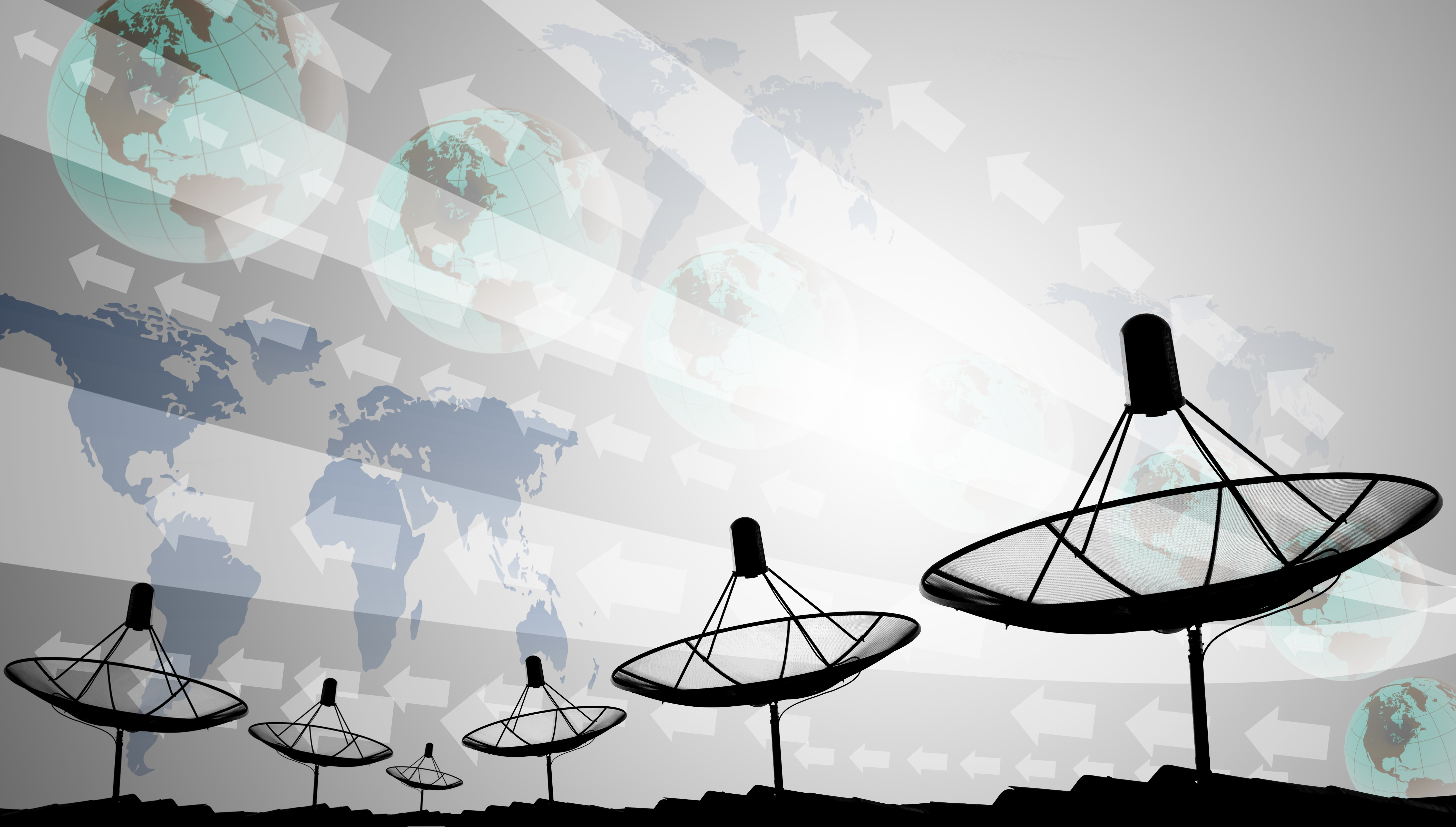
Nearly 20 years later, NASA made that speculation a reality. Hughes Aircraft Company petitioned the FCC to launch the first geosynchronous satellite capable of delivering internet services in 1993. As per usual, the FCC encouraged competitors to launch similar satellites two years later. Yet, it wasn’t until 2003 that the first internet satellite for consumers hit orbit. There are some satellite providers, however just as with their television services, weather and other factors can interrupt the connection. Still, companies like Boeing, Space X, and others are hoping to launch a network of satellites, specifically to offer broadband internet to areas without infrastructure for cable or phone access.
So, while satellite internet is not a great option for places with good phone, cable, and fiber optic coverage, it is a solution for folks who don’t have other options. Users in rural areas and countries without much internet infrastructure can definitely benefit from this technology. Also, the performance of satellite internet continues to improve. A found that nine out of ten satellite internet users saw faster speeds than the providers advertised.
In the early 2010s, satellite internet speeds were nowhere near where they needed to be to compete with other players, hovering between three Mbps and 15 Mbps. The technology promises maximum spends of 1000 Mbps for both uploads and downloads. However, the average spends are less impressive, at just one Mbps for downloads and a measly 256 Kbps for uplinks.
Fiber Optic Cable, the Future-Proof Internet Connection
The concept behind fiber optic communication, that a beam of light can transmit sound, dates all the way back to the late 19th century and Alexander Graham Bell. However, it wasn’t until almost a century later in 1970 when Corning Glass Works invented the first successful optical fiber. When this technology combined with semiconductor lasers, the first “future-proof” communications was truly developed.
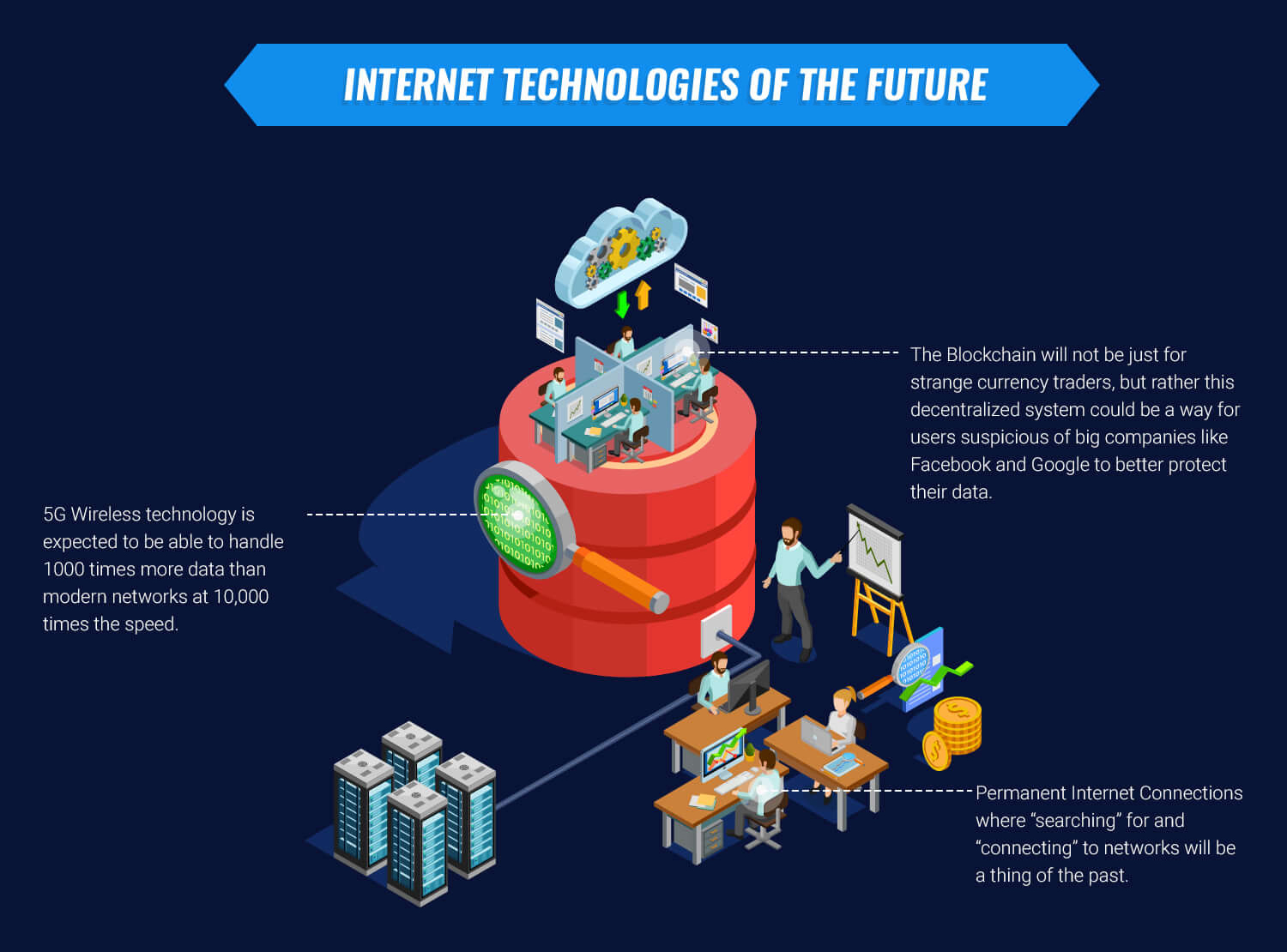
By 1988, the first fiber optic transatlantic phone line was put into service. Still, because developing the necessary infrastructure to deliver fiber optic services, including television, voice communications, and internet, is so expensive, only the giant telecom companies like AT&T and Verizon are really able to pull it off. Verizon FIOS is the largest provider of fiber optic connections, but Google Fiber is slowly positioning itself to be a major, low-cost competitor in this field.
Modern optical fibers are made from silica rather than glass, and it allows for faster, more consistent internet speeds than any other type of connection.
For example, with a 50 Mbps connection on cable or DSL, downloading a movie in high definition or 100 or more music files takes 20 times longer than it would on a fiber optic connection. Currently, residential fiber optic providers have maximum speeds comparable to cable internet, around 1000 Mbps, but this limit has nothing to do with the cables themselves but the technology on either end.
Researchers using standard fiber optic cables are capable of handling speeds measure in Terabytes-per-second. A Terabyte is a million megabytes. Specialized cables used by researchers can provide speeds at more than 100 Tbps, but there will be some time before residential users can see speeds at these levels. However, as newer and newer generations of optical fibers will deliver incredible amounts of data at unbelievable speeds.
With technology growing, but most of the world still behind and some countries offering faster internet speeds at lower costs than developed countries like the US, it will be interesting to see how the future of the internet rolls out.

Share this Image On Your Site
<p><strong>Please include attribution to https://gpunerd.com/ with this graphic.</strong><br /><br /><a href=’https://gpunerd.com/other/internet-speeds-around-the-world’><img src=’https://gpunerd.com/wp-content/uploads/2019/03/Internet-Speeds-Around-the-Globe.jpg’ alt=’Internet Speeds Around the Globe’ width=’1500px’ border=’0′ /></a></p>

